Published Feb 16, 2023
Admiral Red Shirt: Patriarchy on Trial in Star Trek: The Next Generation
The critique of patriarchy at the heart of TNG makes this 35-year old show perpetually one of this fan's favorites.

StarTrek.com / Rob DeHart
If red shirts are the pitiable unnamed crew members likely to die in away missions during Star Trek: The Original Series episodes, Admiral Red Shirt is a similarly doomed character type examined throughout Star Trek: The Next Generation.
Repeatedly, TNG uses an Admiral Red Shirt character to interrogate patriarchy for what the writers, directors, and creator Gene Roddenberry clearly considered its many failings, including dangerous arrogance, a predilection for paranoia, and a commitment to selfish rule breaking. Although TNG’s Admiral Red Shirts don’t die with the regularity of TOS red-shirted crewmen, their reputations and high-level careers in Starfleet are often destroyed by their own terrible decisions.
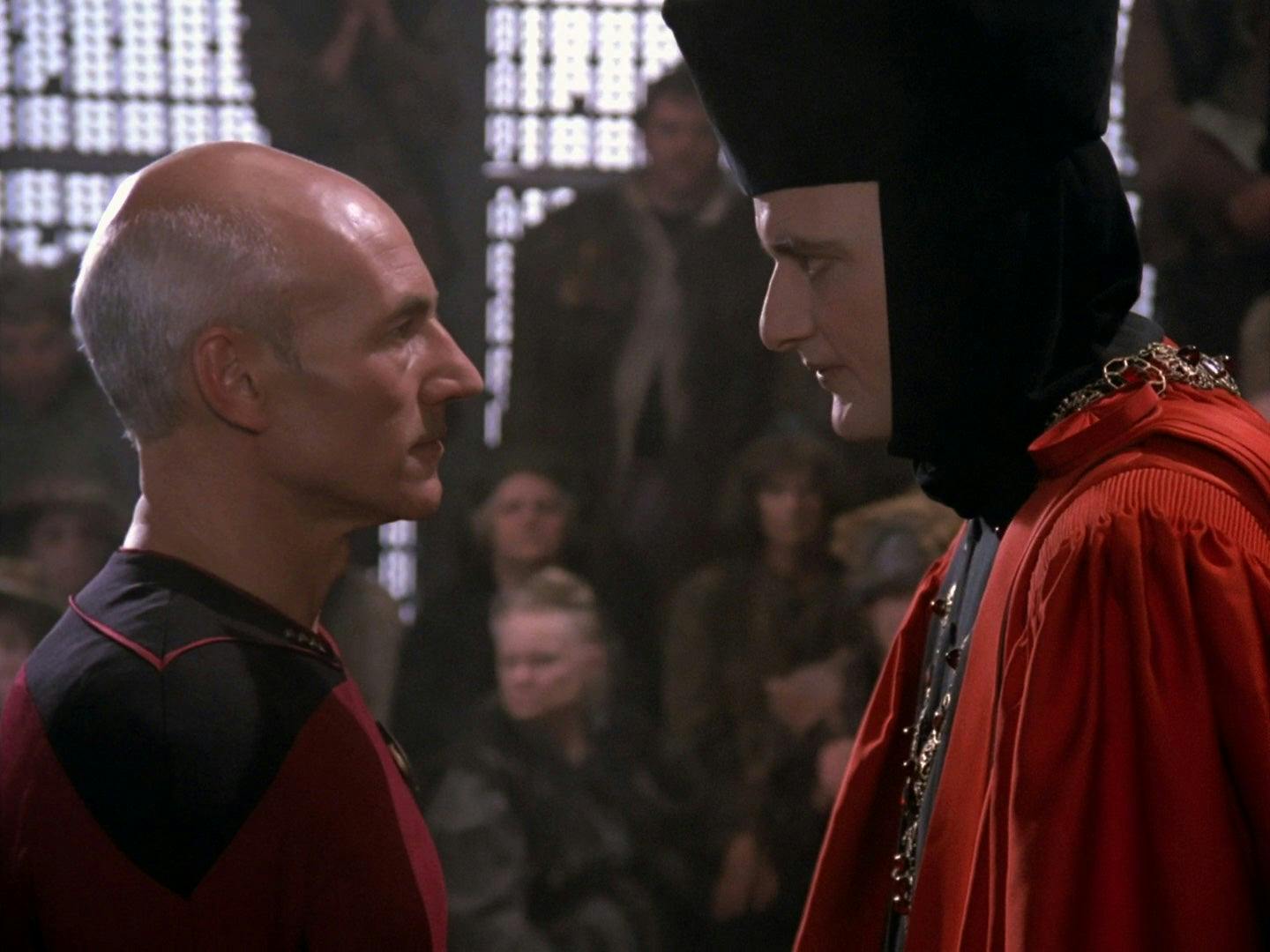
StarTrek.com
[RELATED: A Guide to Star Trek’s Bad Admirals]
As we meet these Admiral Red Shirt characters, it becomes clear they’re very much the type of humans whom omnipotent space pest Q labeled as members of “a dangerous, savage child race” in the first episode “Encounter at Farpoint.” TNG’s pilot episode ends with Captain Jean-Luc Picard and the smart crew of the Enterprise-D demonstrating their non-violent problem-solving skills to Q. However, for the remainder of TNG, Patrick Stewart’s character has a special charge as leader of this galaxy-traveling starship to actively prove to John de Lancie’s Q — and to himself — that he can lead without resorting to the ugliness of violent, self-righteous patriarchy so ubiquitous in humanity.
The critique of patriarchy at the heart of TNG makes this 35-year old show perpetually one of my favorites. “We humans know our past,” Picard admits to Q in the trial scene, “even if we’re ashamed of it.” The shameful past to which Picard refers includes violent and destructive actions of powerful human leaders, such as selfish scientists, rogue military captains, and fanatical admirals, calling all the shots. Of course, human savagery does not completely exist in the past. Picard’s intellectualism, morality, and open mindedness serves as a foil to the very worst in stubborn patriarchy, which we encounter repeatedly in the 24th Century from flawed red-shirted Starfleet leaders like revenge-seeking Captain Benjamin Maxwell (“The Wounded”), authoritarian Captain Edward Jellico (“Chain of Command”), and inscrutable Admiral Alynna Nechayev (“Journey’s End”). When we include TNG’s critique of arrogant, selfish scientists like Kosinski (“Where No One Has Gone Before”), Bruce Maddox (“Measure of a Man”), and Kila Marr (“Silcon Avatar”), this show attacked patriarchal behavior hard, from start to finish.
The storm clouds of poor decision making by Admiral Red Shirt characters begin to gather in TNG’s first season. In “Too Short a Season,” 85-year old Admiral Mark Jameson consumes a reverse-aging drug to be at his “best” upon returning to the site of his worst decision decades before. He tried to “level the playing field,” by giving weapons to both sides of a conflict on Mordan IV which resulted in many bloody years of war. His return does not go well, but at least the governor allows Admiral Red Shirt Jameson to be buried on the planet of his greatest failure. In the extra weird Season 1 episode “Conspiracy,” Admirals Savar, Aaron, and Quinn are infected by a controlling alien parasite that wants to take over Starfleet. The conflict in these early episodes reflects the difficulty of challenging an admiral who’s been compromised. These Admiral Red Shirts don’t appear to answer to any superior officer except generalized Starfleet — they’re used to making and breaking the rules for their own ego and benefit. These episodes prepare us to distrust Admiral Red Shirts throughout TNG.
Vice Admiral Anthony Haftel
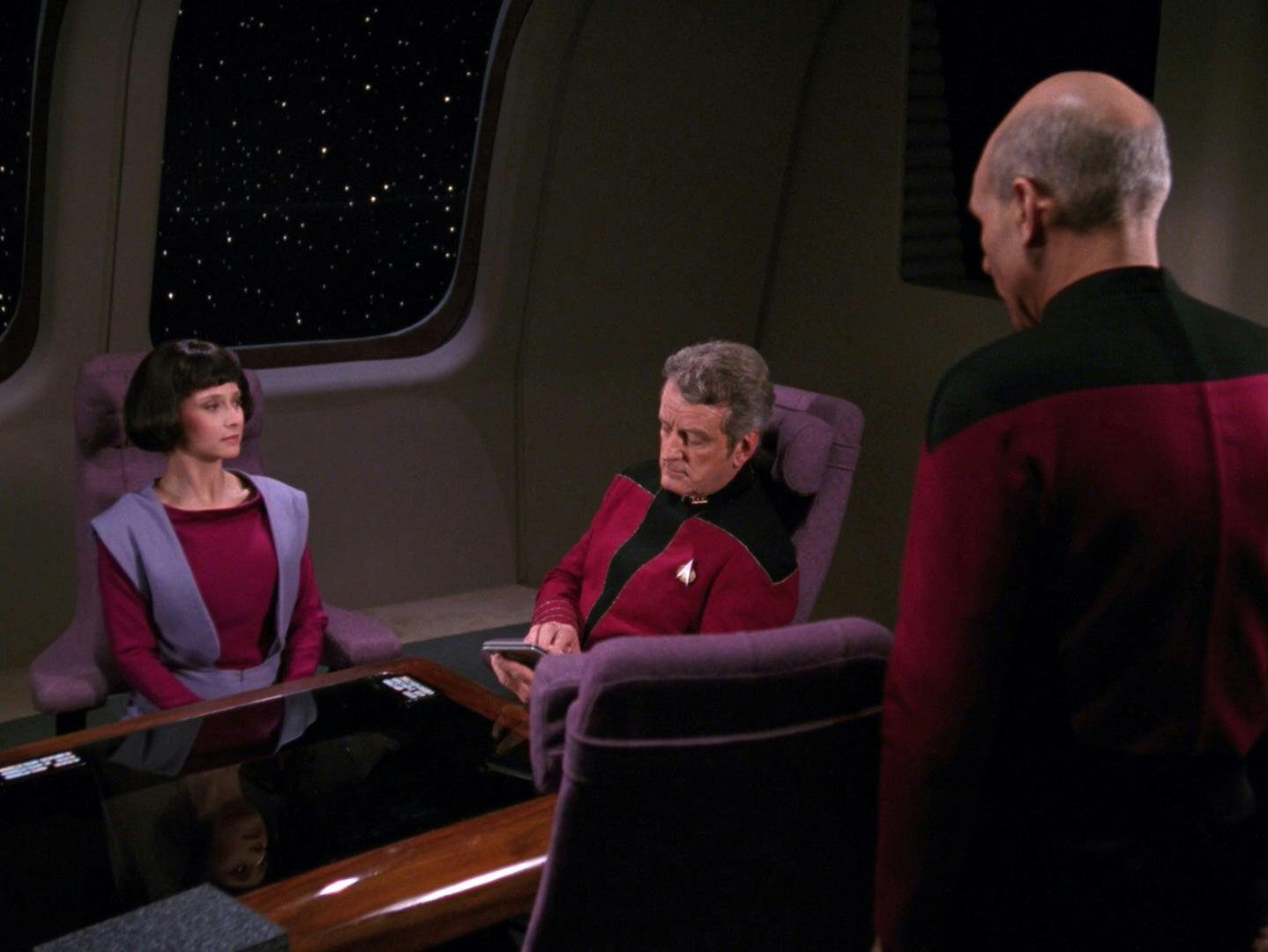
StarTrek.com
The patriarchy roast really gets cooking in Season 3’s “The Offspring,” where we see the deadly consequences of pushy Admiral Red Shirt behavior on a brand new positronic brain. Imperious cybernetic specialist Vice Admiral Anthony Haftel so traumatizes Data’s new daughter Lal with orders to leave Enterprise, her positronic brain trips, overloads, and requires deactivation. Everything had been developing naturally (for an android) until the admiral arrived. Causing synthetic Lal’s new positronic brain to initiate cascade failure was a terrible mistake on Admiral Red Shirt Haftel’s part. “Follow my orders!” is more important to him than, “What’s the right thing to do here?”
Rear Admiral Norah Satie
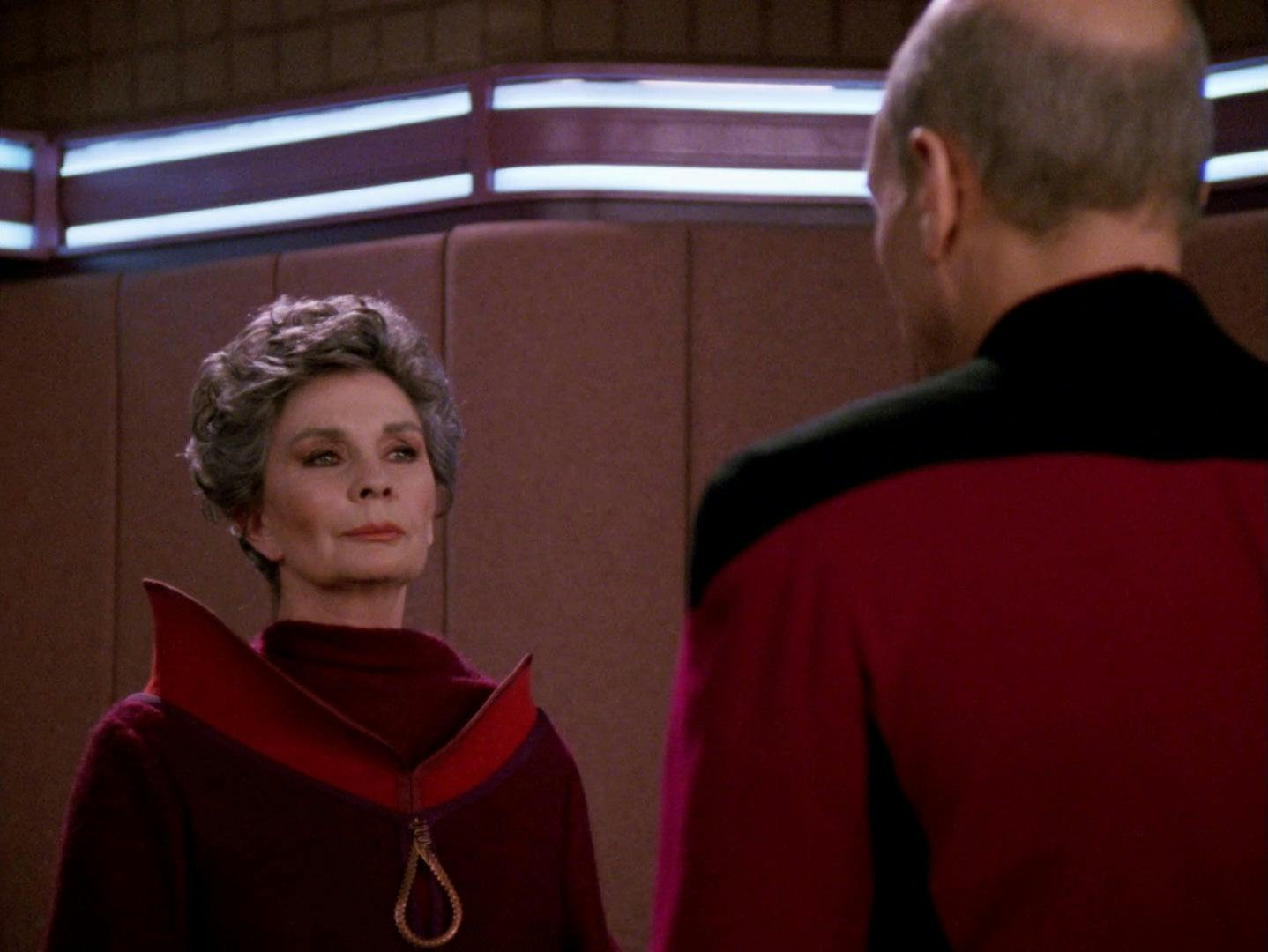
StarTrek.com
I enjoy Star Trek episodes that critique inadequate patriarchal leadership and offer a more positive and effective way to lead. Season 4’s “The Drumhead,” an exceptional TNG episode that remains chillingly relevant today, features a fanatical and paranoid Rear Admiral Norah Satie, the daughter of a famous Starfleet judge. Like a Senator Joe McCarthy-of-the-future, she imagines conspiracies everywhere on Enterprise, especially after Picard’s terrible experience with the Borg. Admiral Red Shirt Satie is a perfect example of a woman using patriarchy to further her own power; like so many women across human history, she’s a foot soldier for patriarchy and aggressively wields fear to preserve her own powerful position within this flawed system.
When the proceedings are finally aborted and Satie departs Enterprise, as Worf and Picard struggle to process the experience of the admiral putting the captain on trial, Picard’s observations remain relevant to our current day — “We think we've come so far. The torture of heretics, the burning of witches; it's all ancient history. Then, before you can blink an eye, it suddenly threatens to start all over again.” When Worf wonders if people may approach her accusations with more skepticism in future, Picard replies, “Maybe. But she, or someone like her, will always be with us, waiting for the right climate in which to flourish, spreading fear in the name of righteousness.” Despite her polished outward appearance, Admiral Red Shirt Satie demonstrates that she is, at her core, one of Q’s nightmare humans in our sometimes “dangerous, savage child race.”
Admiral Erik Pressman
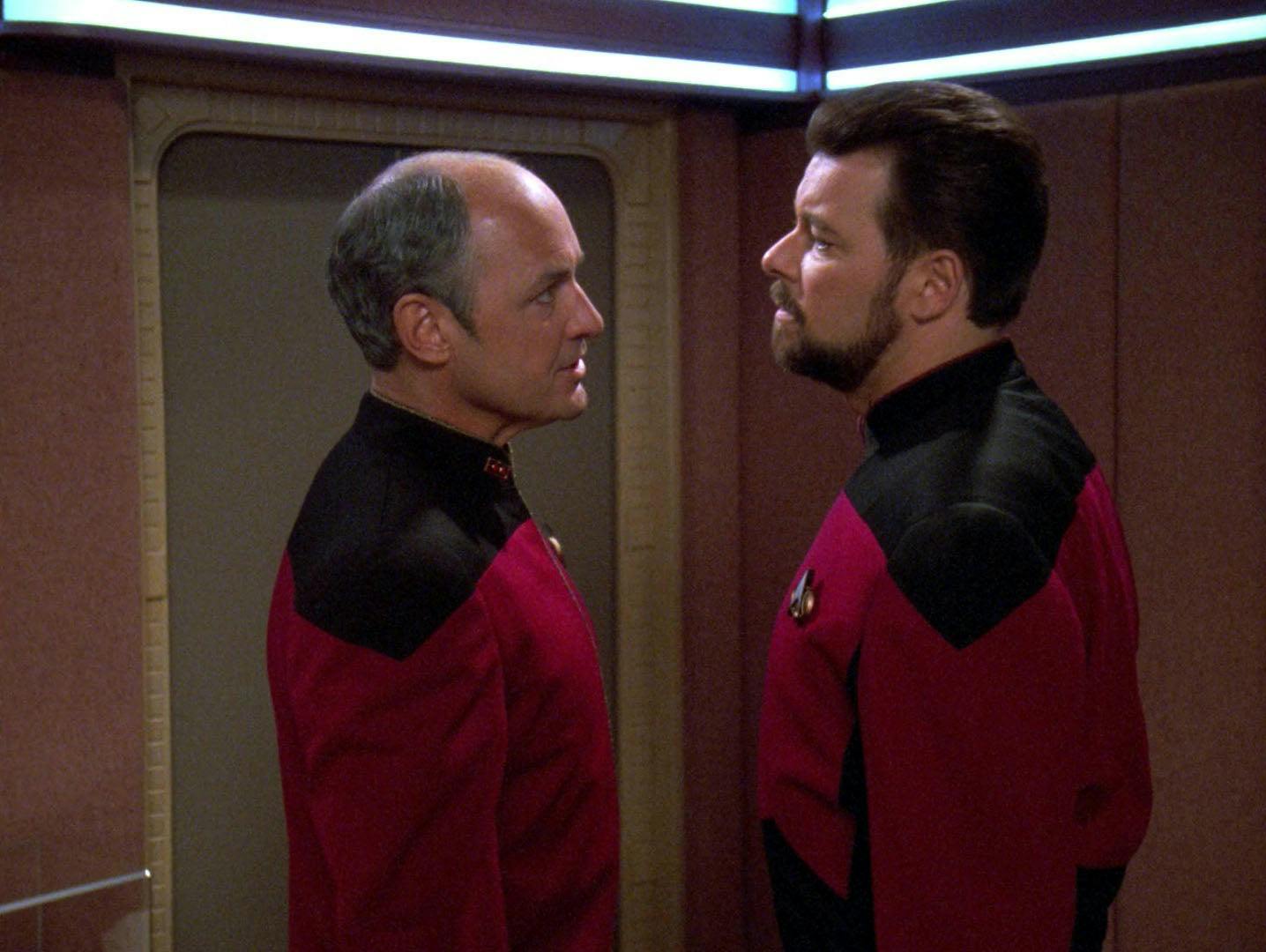
StarTrek.com
In the final season, TNG’s writers heightened the stakes of their Admiral Red Shirt patriarchy critique with a story that involves a power-play between the Romulans, Captain Picard, his first officer Commander Will Riker, and Riker’s first captain, who has since been promoted to Admiral Erik Pressman. Pressman, a manipulative officer who thinks he answers to no one, is searching for an illegal cloaking device that Starfleet Intelligence wants in order “to level the playing field” with the Romulans, despite the treaty violation.
At the end of “Encounter at Farpoint,” Riker tells Q that “Humanity is no longer a savage race.” “But you must still prove that,” purrs Q before disappearing in a flash. In fact, Riker’s difficult choice in “The Pegasus” serves as a type of “final exam” of Q’s assessment of latent human savagery. The choice? Follow the orders of a fanatical patriarchal bully figure who demands obedience to his dangerous ideas, or align with Captain Picard in pushing back against this unfit “leader” and promoting the values of Starfleet. We love this show because Riker chooses wisely. Hope you enjoyed your court-martial, Admiral Red Shirt Pressman.
Admiral Katrina Cornwell

StarTrek.com
Knowing that fans are conditioned to expect deeply flawed Admiral Red Shirt characters, Alex Kurtzman-era Star Trek deploys surprisingly noble admirals to flip this script. In Season 1 of Star Trek: Discovery, desperate Admiral Katrina Cornwell almost becomes yet another human leader to make the most savage choice when she orders the destruction of Qo'noS per Emperor Georgiou’s plan to end the war with the Klingons. Our hero Michael Burnham helps remind Admiral Cornwell how to be a true Starfleet leader and to find another way than genocide.
By the end of Season 2, Admiral Cornwell sacrifices herself to save Enterprise from a massive explosion and secures her position as one of the best Starfleet admirals in any Star Trek.
Admiral Charles Vance
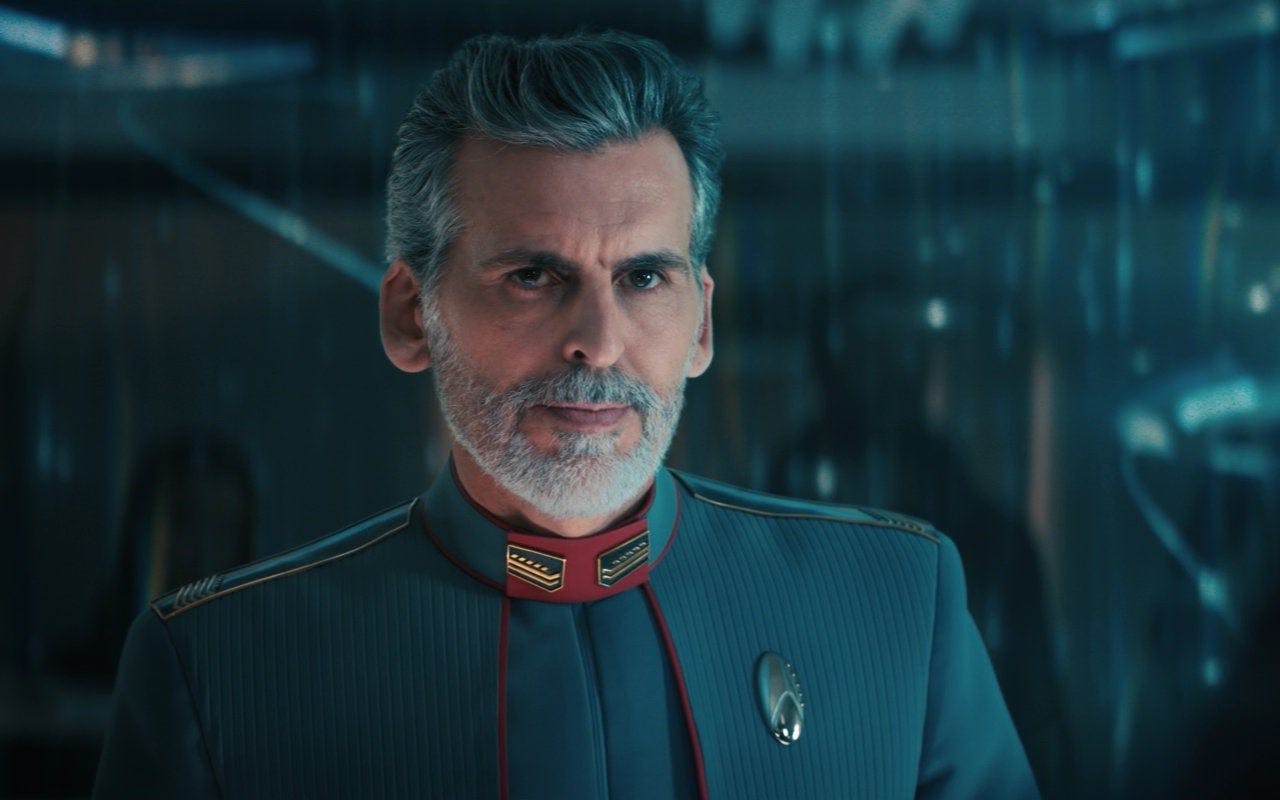
StarTrek.com
Despite the noble sacrifice of Admiral Cornwell, when Burnham and her starship travelled 930 years into the future and finally found Starfleet’s hidden headquarters, I wasn’t the only Star Trek fan who assumed prickly Admiral Charles Vance would be as terrible as those TNG Admiral Red Shirts. As intended, I immediately distrusted him for deciding to break up Discovery’s crew and coming across as harsh and cold.
However, Kurtzman and showrunner Michelle Paradise gave Vance a redemption arc in Season 3 that helps us understand his initial defensive crouch and makes him the kind of leader capable of growth that Starfleet needs to rebuild in this damaged future. I respect TNG for its sustained attack on patriarchy but, after seeing the endless failures of all those Admiral Red Shirts, I’m grateful to Star Trek: Discovery for redeeming some decision-makers at the top of the Federation and showing us effective, empathetic, and selfless leadership worthy of Starfleet ideals.
Writer R. A. Duchak (she/her) was in utero when Armstrong and Aldrin walked on the moon, and she’s been a space nerd ever since. She has worked as a radio host and producer, university writing instructor, webmaster, editor, and Outward Bound instructor. You can find her on Twitter @ccfoodie.
Star Trek: Discovery Seasons 1-4 are currently streaming exclusively on Paramount+ in the U.S. Internationally, the series is available on Paramount+ in Australia, Italy, Latin America, the U.K. and South Korea, as well as on Pluto TV in Austria, France, Germany, Italy, Spain and Switzerland on the Pluto TV Sci-Fi channel. It will also stream exclusively on Paramount+ in Italy, France, Germany, Switzerland and Austria later this year. In Canada, it airs on Bell Media’s CTV Sci-Fi Channel and streams on Crave. STAR TREK: DISCOVERY is distributed by Paramount Global Content Distribution.
Stay tuned to StarTrek.com for more details! And be sure to follow @StarTrek on Facebook, Twitter, and Instagram.

